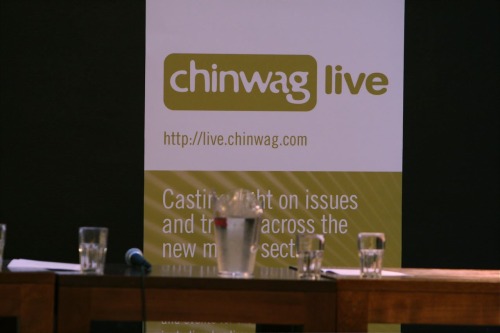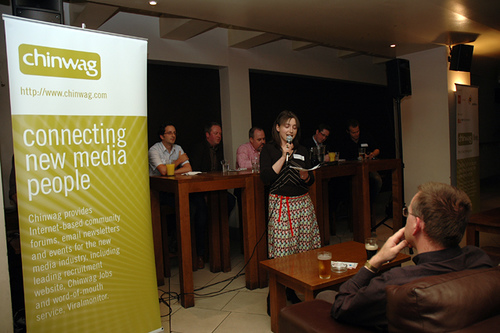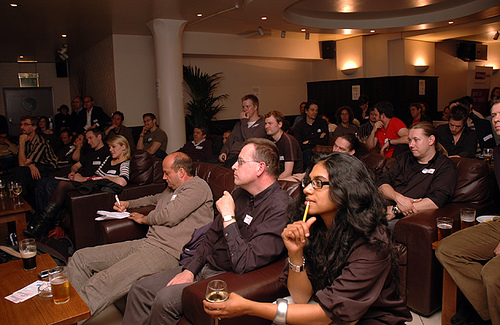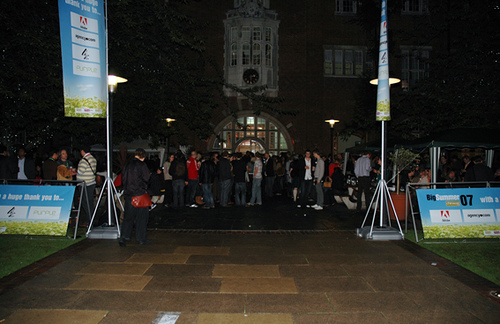Convened (as it emerged) at the behest of Valleywag’s chief scribe Owen Thomas, this session was among the best I attended at SXSW Interactive 2008, as much for the social static and currents it generated as for cerebral reasons.
Plus as a lifelong dyed-in-the-wool observer I’ve latterly realised I’m an anthropology nerd 😉
Featuring (L-R in my photo):
Alan Citron – General Manager, TMZ
Owen Thomas – Managing Editor, Valleywag
Chair: Heather Gold – Writer/Performer, Subvert.com
Julia Allison – Reporter, Star magazine (invited onto panel in real-time)
Shaila Dewan – National Correspondent (South), New York Times
Evan Williams – Co-Founder, Twitter/Obvious
Heather Gold did a tremendous job of chairing. A professional stand-up comic and longtime geek who’s been running her Heather Gold Show in the evening fringe scene at SXSW for a few years, she was the doyen of conversation, getting everyone involved. Like the referee of your dreams, she allowed volleys of audience questions right through the session while still giving each panellist their say. Question Time was never like this.
“I like to organise conversations around things that people really care about… this will run like a collective inquiry as you all have as much expertise on who you are and on the world as we have on our points of view so you’re all welcome to join in.”
Heather, I salute you!
She didn’t stand for any bullshit either. Panelists had to *answer* the questions (until the very end part, that is…), and cutting across other folks was fluently de-engineered by the Gold MC.
Okay, several paragraphs in and no gossip! As Twitter dominated a lot of the discussion Heather first canvassed the 100-strong audience for those who didn’t know what Twitter was – there were a handful. Twitter founder Ev Williams helpfully flagged-up a new online video from Lee LeFever of Commoncraft ‘Twitter In Plain English’ which gives a concise explanation to newbies (Twitter have since added this video to their homepage – I hope Lee got paid).
Supercharged telegrams from the frontline
Speaking for the power and usefulness of Twitter, Heather explained that she follows Bara Tunday on Twitter for news on the Obama campaign – he’s a technologist in Barack’s official team and his tweets tell her more about Obama than the New York Times does.
Owen Thomas described Valleywag as Silicon Valley’s tech gossip rag. But he cited Chris Nolan’s groundbreaking work (for the San Jose Mercury News) in merging tech biz news and personalities as a big inspiration to him. Thomas earned his spurs in tech journalism, having previously worked for Wired, Time magazine, Red Herring (version 1.0), Business 2.0 (recently deceased) and – his favourite – Suck.com, amongst others. Nolan’s ability to create a real, tight connection with readers is the other trait Owen strives for with Valleywag.
So what is gossip? Thomas defines it as “what people are talking about, and that is inherently interesting… My first filter and inspiration for writing a post is: is this something people are talking about? Thanks to people like Ev, technology is making gossip more efficient. And ‘efficiency’ is the word of the day,” he added in a snarky allusion to Mark Zuckerberg’s keynote two hours earlier.
At this point he was booed and heckled by audience member Julia Allison who was then invited onto the panel by Gold. Web TV presenter for the Star magazine gossip site, Allison said she writes about Britney, Paris, Lindsay et al, but in her view “this shit shouldn’t matter.”
Respite from & comfort blanket against what we can’t change…
Shaila Dewan of NYT described herself as “a newspaper reporter”. She covers “the southlands… fires in sugar refineries, hurricanes, the human fallout from Hurricane Katrina, and what the government didn’t do about it, that kind of thing.”
Alan Citron described TMZ as an online celebrity news site that is also becoming a video/web TV show. He’s the general manager but also a former journalist of 13 years standing at the LA Times. He was away from journalism for around 10 years doing other jobs on the internet, and while he isn’t actually interested in it, Alan liked getting into celebrity gossip because it reminded him of what he liked about journalism: getting back to and helping create a news group, helping to deciding what this thing was going to be, figuring out how to make it bigger, even as the business guy you get to participate in those decisions. Especially early on, it was just like being back in journalism. And that’s why he took the job
Why is it doing so well, Heather wondered. Citron’s reply spoke volumes:
“It’s an insatiable appetite – whether it’s bullshit, or whether its good for you, or whether it’s a convenient distraction from Iraq and other things like that which are exhausting…There’s always that one person that someone is following, or a roster of celebrity stars – it’s like their little mental vacation.”
Rags to riches: profiting from gossip
It’s certainly big business for TMZ, as Alan revealed. They average 7 million page views per day and according to Ominiture they had 30 million unique users in February 2008, although it was a big month for celebrities as Heath Ledger committed suicide and Britney lost custody of her kids, Citron added. “And it’s not just here, it’s everywhere, this is a worldwide phenomenon.”
TMZ became profitable after just 11 months. They had 25 staff when it was just a website, now it’s 150 as television production is more production-intensive.
Valleywag has three full-time staff and three contributors. Last month (February 2008 ) they got 4.5 million page views, Owen said.
How can these gossip rags possibly keep up with Twitter, Heather asked. Ev replied that it’s all just part of an ecosystem. Heather quipped “did you say ecosystem or egosystem?” Que hilarity. Next Heather lobbed the ‘what is gossip’ query over to Ev. “The best gossip is about people you know,” Ev said.
Expanding on her Twitter-as-lightning-rod-news-source theory, Heather said following Jason Calacanis on Twitter is the fastest tech news you can get. How does he manage to tweet so much? Owen’s theory was that Calacanis is bulldog-sourcing it (ie. it’s a collaborative effort with his beloved bulldogs).
The democratization of celebrity and public life
Audience question: What’s the minimum level of fame needed to be pictured drinking a milkshake on Valleywag? Owen countered that people in the tech industry are “interested in other people that are not company CEOs. The internet has changed the nature of publicity, the nature of who is a public figure.”
“Don’t put your relationships online,” Julia warned, adding that she’d learned the hard way (in reference to a dalliance with the founder of Vimeo) – “because then people will feel they have a right to comment on them, and that (even if they don’t know you) they are somehow part of the relationship.”
Alan Citron commented that there are more and more layers of people who now qualify as celebrities, “like the person who gets disqualified from the third round of American Idol. More and more people are being sucked into this celebrity thing, and we’re not ready for it.”
“The Zuckerberg [Lacy keynote interview] interest on Twitter today is all about what we call the banana peel moment”, he continued, but Heather countered that “the thing with embarrassing is that if we own it it’s not embarrassing.”
Majority rules and the shifting sands of trust
“Gossip is a way of enforcing societal norms, the way we act and how we judge each other,” Allison astutely reflected. “Facebook is a tool for people to gossip and hook-up,” she added, somewhat more mundanely.
“There isn’t a clear line”, said Ev Williams, “we use tools to do things we’ve always done.” He also had a question-cum-comment that raised broader issues about trust, expertise and the cultural effects of people media.
“You learn after a while that the media is usually really inaccurate if it’s about a topic you know a lot about, but if you don’t know about it you think it’s accurate. As the bar lowers on who is covered in media, will people just learn to distrust all media across the board? And therefore maybe (a) it’s not as hurtful [when you’re gossiped about] and (b) everything’s more critically looked at?”
Giving each other a break…
Heather said in her experience there more open you are about things the less you’re gossiped about. If there were a story about you but you’d already blogged the details wouldn’t people rather go to that blog and read about it directly from the person’s own mind and experience as opposed to someone else’s report of it? Ev rejoined: “In theory. That’s a good defence of people not calling you a schmuck – by calling yourself a schmuck first.”
[Hmm, Isn’t this personal equivalent of “declarative living” a lot more fraught, or am I just out of touch with the zeitgeist?] 😉
At this point my notes became sketchy as I scribbled out a few bullet points for what I wanted to say and joined the standing line queue for the mike….
Anil Dash (of Six Apart) said the “they” is fraudulent, we’re all doing this and we’ve all been on both sides of it – he’s had death threats come in through his blog, and he also had great things happen (because of his blog) and all of it is reported as if he’s not a person. But we built the tools – it’s our fault, he stressed.
New concepts of authority and working the gossip game
“Notions of authority are generationally changing,” Heather noted… “If we are the media we are now reporting on ourselves.” “We are all the thing that we are saying is a problem”, Anil retorted. Julia Allison wondered if isn’t the answer to be very conscientious – people don’t have context when reading these stories as they don’t know the person. [Which sounded like an update on the longstanding demand for media literacy to me; however, in lieu of education’s inability to adapt to the pervasive media society, haven’t we always just provided this literacy for ourselves?]
Someone from Mediamatters.org said if something is picked up in the liberal blogosphere it often goes no further than that unless there is an element of it that holds interest for other parties. But if something involves gossip it can go a lot further – in that way gossip can be good.
The divergent effects of gossip on men and women came up – if a woman is gossiped about she is considered a slut, if it’s a man, he’s a stud. But (rightly in my view) Heather parked this, as we just didn’t have time to go into the whole gender divide and representation topic.
Identity management in the digital age
My observation to the panel was this: In this era of instant gossip and the democratization of gossip, where everybody’s gossiping about each other in public and it’ll be there for years somewhere, cached on Google etc, there’s still a divide. When famous people are being covered by Star magazine or whoever, they’ve got managers and PRs and flacks who will give them feedback on that and they can sometimes try to turn this around to their advantage and they’ll be protected; whereas you and I don’t have handlers, minders, PR people.
So what you need to think about is identity management and how you handle yourself and your reputation. Everything is not going to become transparent, and it really annoys me when people say that it will, because people still want parts of their lives to themselves, they might share it with a couple of other people but not everyone else.
What do the panel think about the idea that we all need to help each other out and give each other more advice on this? There’s a video I saw recently on Videojug ‘How To Behave On An Internet Forum’, which may be in some ways a bit dated, but it relates to this issue of how do you behave in this community where anyone can participate? So how should we handle ourselves to protect ourselves from the malevolent gossip and the useless gossip?
Julia jumped in to proffer her response and didn’t answer my question at all, she just echoed the sentiment and said it’s unfair on people who can’t afford to defend themselves from this gossip. I wish someone else had answered! 😦
Navigating through the “all-seeing we”
Nick Douglas from Gawker (and formerly Valleywag) sardonically observed that even if people respond to what’s written about them, the likes of Gawker and Valleywag just turn it back into another story because they want to pull it back into the machine that makes us money and makes us feel good because (que quotation mark gesture) “we’re better” than Julia (or whoever they’re writing about).
Lane Becker of Getsatisfaction (and formerly Adaptive Path) cited this as the best SXSW panel he’d ever been in.
He quoted from an earlier panel Heather had been on, “Climb to heaven on the backs of your enemies corpses!” This stuff is going to work out for you really well in the long term, he said to Julia (and, by inference, all of her ilk). Part of success is being willing to be a public persona.
The performative aspect of being in the industry is just part of being in the game, he continued. He also relayed his own brush with micro-celebrity gossip when Valleywag published a photo of him in the bath with four other under-dressed people. And one of those people was his wife standing up in her underwear and swigging back a bottle of Champagne. Another was Jason Fried of 37 Signals.
Which recycled nugget of gossip from the subject was a perfect end to the session…
—-
FURTHER COVERAGE OF THIS PANEL
Valleywag
http://valleywag.com/365674/julia-allison-crashes-sxsw-explains-it-all
Nowpublic live blog
http://www.nowpublic.com/culture/nowpublic-sxsw2008-liveblogging-now-gossip-sunday
Guardian Digital Content blog PDA http://blogs.guardian.co.uk/digitalcontent/2008/03/sxsw_how_gossip_feeds_the_web.html
Los Angeles Times
http://latimesblogs.latimes.com/webscout/2008/03/gossip-panel-de.html
Session video (on Blip.tv)
http://blip.tv/file/745166/
Gossip panel podcast on SXSW Interactive website (in April 2008 archive)
http://2008.sxsw.com/coverage/podcasts/
For a deeper, earlier examination of somke of the same issues, check out the Chinwag Live panel from June 2007…
The Dark Side Of Social Media (London, 19th June 2007)
http://podcasts.chinwag.com/cl6-full.mp3







